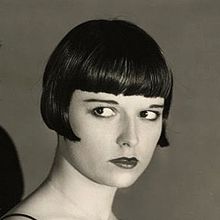Bob hairstyle

The bob hairstyle is a short hairstyle for women and girls. The hairstyle is a variant of the bob that came up around 1920. It was influenced by the "boy type", the image of women of the time, and quickly became the most popular hair fashion.
Hairstyle in the time of change
The hair was worn about chin length and straight, with bangs or side parting, with or without waves. Special forms such as the " Pagenschnitt " and the "Etonschnitt", short at the back of the head like the men, were all the rage. In between there was the "gust of wind" with hair combed or brushed up from the temples. For the evening appearance, the severely parted hair was supported by pomade close to the head. The permanent wave was invented in 1906 and made curly short hairstyles in addition to the straight bob hairstyle.
Like the fashionable creations of the “ Charleston Era ”, the short hairstyle went hand in hand with social change and the changed position of - increasingly employed - women in the period after the First World War . The bobble head, like the tight pot hat , the short skirt and the legs in silk stockings, was one of the external features of the “New Woman”, which the fashion magazines reduced to attributes such as clothing style, youthfulness, sportiness or motorization. A connection between the fashionable appearance and the emancipatory idea became apparent from around 1924. At that time, economic stabilization began in Germany in the wake of the Dawes Plan , and women, attracted by the somewhat higher industrial wages, increasingly moved to the big cities. As a result, in the course of real emancipation, the attitude and appearance of women were equated.
Well-known protagonists
One of the most famous protagonists was the American dancer Irene Castle . In 1915, she was the first to dare to have a bob haircut and use it to dance across European and American cabaret stages. In Paris, after the war, fashion designer Coco Chanel celebrated her first successes with sweaters, short skirts and trousers, while at the same time promoting short haircuts for women. In Germany, Asta Nielsen caused a sensation in the 1921 film adaptation of Shakespeare's Hamlet with the boyish pony hairstyle and quickly found many imitators. The breakthrough for the American actress Colleen Moore came when she had her hair styled in a bob for the film Flaming Youth in 1923 and thus became a model for the “ flappers ” of the “Jazz Age” or the “ Roaring Twenties ”. The best-known representative of this new image of women was the actress Louise Brooks .
literature
- Entry bob hair . In: Meyers Enzyklopädisches Lexikon . Bibliographical Institute, Mannheim / Vienna / Zurich 1973, Volume 4, p. 846.
- Erika Thiel: History of the Costume . Henschel-Verlag, Berlin 2004, ISBN 3-89487-260-8 , p. 402.
- Michael Bienert, Elke Linda Buchholz: The Twenties in Berlin - A guide through the city. Berlin Story Verlag, Berlin 2005, ISBN 978-3-929829-28-0 .
Individual evidence
- ↑ Bodo Harenberg (Ed.): The Chronicle of Berlin . Chronik Verlag, Dortmund 1986/1991, ISBN 3-88379-082-6 , p. 365.
- ↑ Gesa Kessemeier: Sporty, businesslike, male - the image of the “new woman” in the twenties. For the construction of gender-specific body images in fashion from 1920 to 1929. Edition Ebersbach, Dortmund 2000, ISBN 3-934703-04-6 .
- ↑ Bodo Harenberg (ed.): The Chronicle of Women . Chronik Verlag, Dortmund 1982, ISBN 3-611-00195-3 , p. 452.
